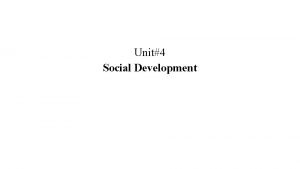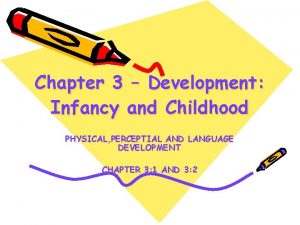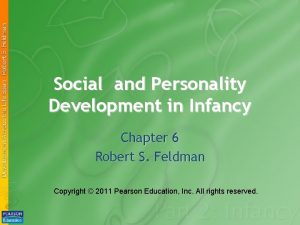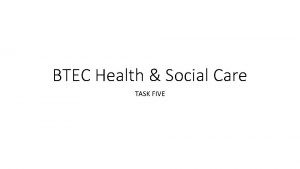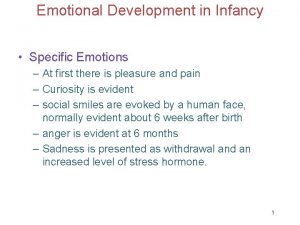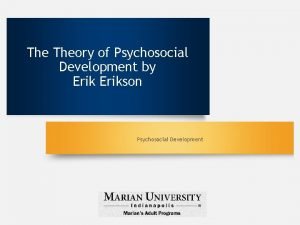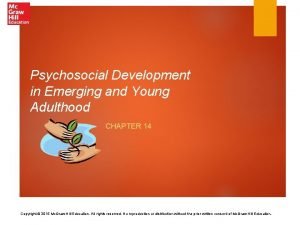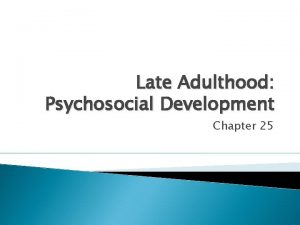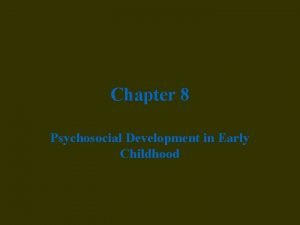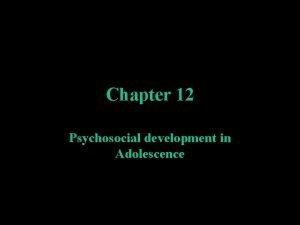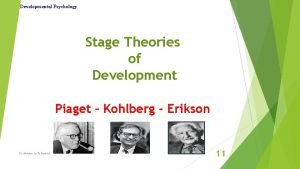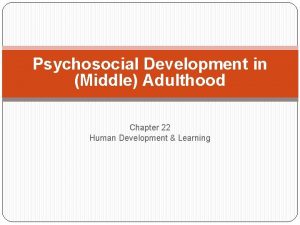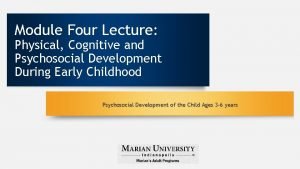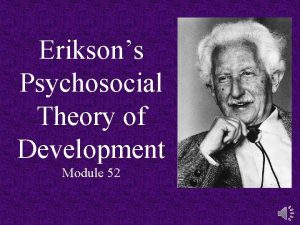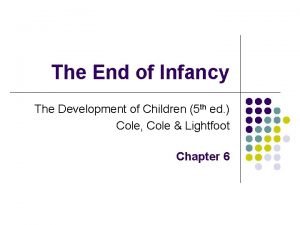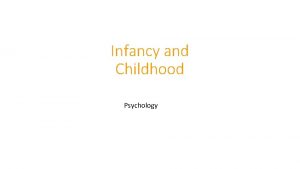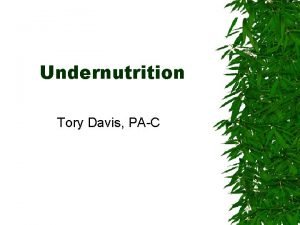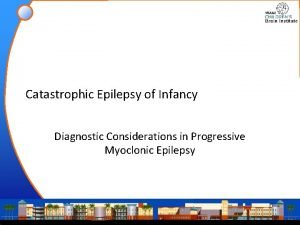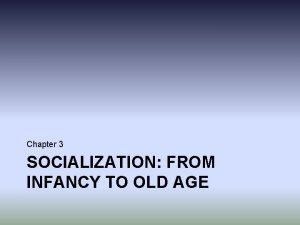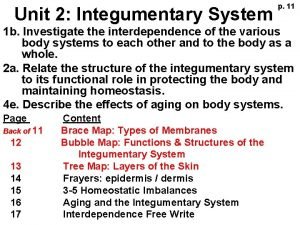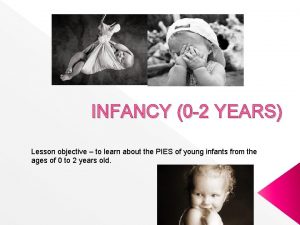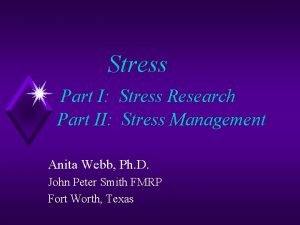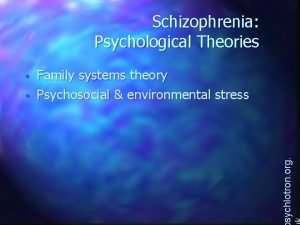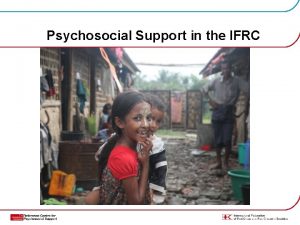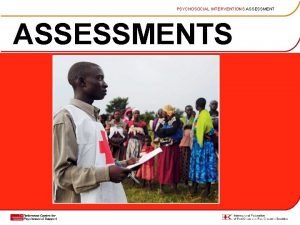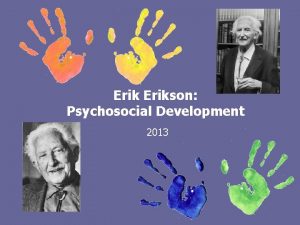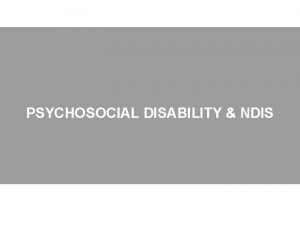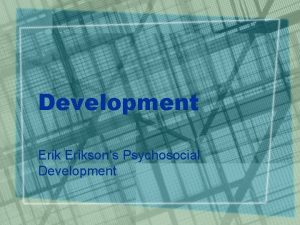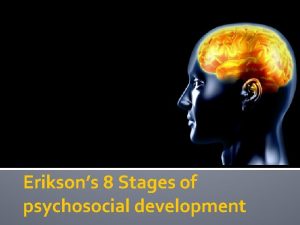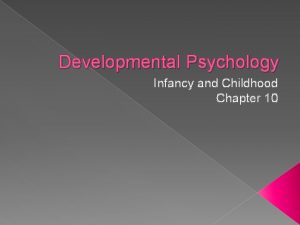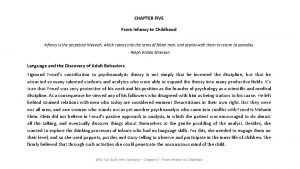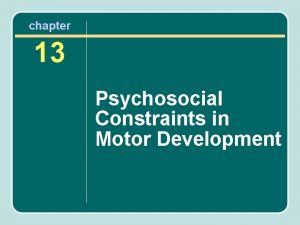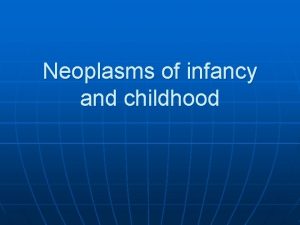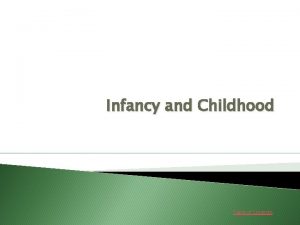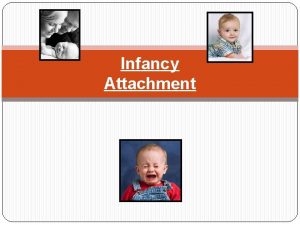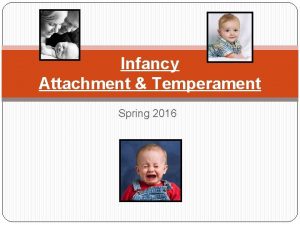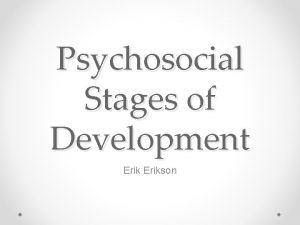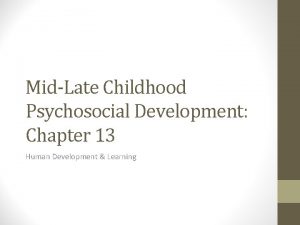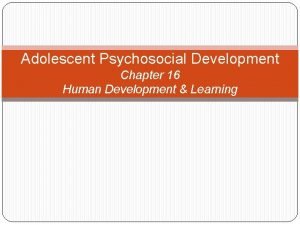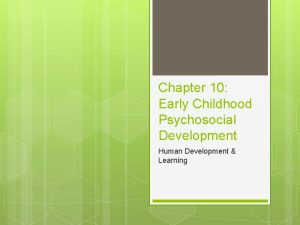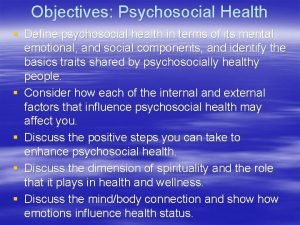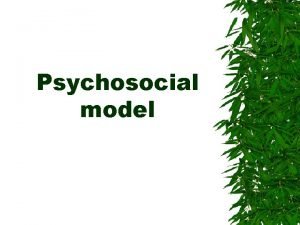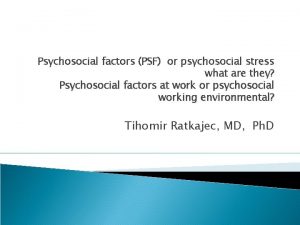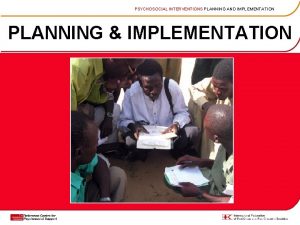Psychosocial Development in Infancy Chapter 7 Human Development

















































- Slides: 49

Psychosocial Development in Infancy: Chapter 7 Human Development & Learning

Hail Mary, full of grace! The Lord is with thee; blessed art thou among women, and blessed is the fruit of thy womb, Jesus. Holy Mary, Mother of God, pray for us sinners now and at the hour of our death. Amen.

Where we are headed… Emotional development in infancy Primary/Secondary Emotions Temperament Theories of psychosocial development Development of social bonds (Attachment) Fathers and infant care

Emotional Development in Infancy

Emotional Development

First 6 months: Surprise, interest, joy, anger, sadness, fear, disgust

Emotional Development Infants’ Emotions Smiling and Laughing Social smile (6 weeks): Evoked by viewing human faces Laughter (3 to 4 months): Often associated with curiosity Anger First expressions at around 6 month Healthy response to frustration Sadness Indicates withdrawal and is accompanied by increased production of cortisol Stressful experience for infants

Emotional Development Fear: Emerges at about 9 months in response to people, things, or situations Stranger wariness: Infant no longer smiles at any friendly face but cries or looks frightened when an unfamiliar person moves too close Separation anxiety: Tears, dismay, or anger when a familiar caregiver leaves. Normal at age 1, intensifies by age 2 If it remains strong after age 3, it may be considered an emotional disorder.

Toddler’s Emotions Anger and fear become less frequent and more focused Laughing and crying become louder and more discriminating New emotions: Pride Shame Embarrassment Guilt Require an awareness of other people Emerge from family interactions, influenced by the culture By age 2, children can display the entire spectrum of emotion

Emotional Development Self-awareness A person’s realization that he or she is a distinct individual whose body, mind, and actions are separate from those of other people. First 4 months: Infants have no sense of self and may see themselves as part of their mothers. * 5 months: Infants begin to develop an awareness of themselves as separate from their mothers. * 15 -18 months: Emergence of the Me-self Sense of self as the “object of one’s knowledge” * This is what your textbook says, but research suggests that this is not the case. See slide notes

Emotional Development Classic experiment (Lewis & Brooks, 1978) Babies aged 9– 24 months looked into a mirror after a dot of rouge had been put on their noses. None of the babies younger than 12 months old reacted as if they knew the mark was on them. 15 - to 24 -month-olds: Showed self-awareness by touching their own noses with curiosity. Video: Rouge test

Social Impulses Emotional Self-regulation Directly connected to maturation of the anterior cingulate gyrus Particular people begin to arouse specific emotions Toddlers get angry when a teasing older sibling approaches them or react with fear when entering the doctor’s office. Memory triggers specific emotions based on previous experiences. Link: Empathy in Infants

Stress Excessive stress can alter the brain Hypothalamus may grow more slowly Heightened stress activation Cognitive changes (e. g. , threat sensitivity) Resilience? Strategies for reducing stress: Support new mothers Involve fathers in infant care Strengthen parental alliance

The HPA Axis The hypothalamus in the brain is in charge of the stress response. When a stress response is triggered, it sends signals to two other structures: the pituitary gland, and the adrenal medulla. These short term responses are produced by The Fight or Flight Response via the Sympathomedullary Pathway (SAM). Long term stress is regulated by the Hypothalamic Pituitary-Adrenal (HPA) system.

Emotional Synesthesia? Early emotional confusion due possibly to underdeveloped brain structure that allows electrical impulses to spread across and activate different areas of the brain. Baby Oliver wakes up with every emotion

Temperament

Theories of Infant Psychosocial Development Temperament Inborn differences between one person and another in emotions, activity, and self-regulation Temperament is epigenetic, originating in the genes but affected by child-rearing practices Closely linked to personality

Temperament Chess and Thomas’ Classification Three basic types or clusters Easy child (40%): positive mood; quickly establishes routines; adapts easily to new experiences Difficult child (10%): reacts negatively; cries frequently; has irregular routines; slow to accept new experiences Slow-to-warm-up child (15%): low activity level; somewhat negative; shows low adaptability; displays low-intensity mood

Temperament Over Time Longitudinal study of infant temperament (Fox et al. , 2001): Grouped 4 -month-olds into three distinct types based on responses to fearful stimulation Positive (exuberant) Negative Inhibited (fearful vs. low reactive) Less than half altered their responses as they grew older Fearful infants were most likely to change Exuberant infants were least likely to change Maturation and child rearing has effect on inborn temperament

Theories of Infant Psychosocial Development

Goodness of Fit A similarity of temperament and values that produces a smooth interaction between an individual and his or her social context, including family, school, and community With a good fit parents of difficult babies build a close relationship parents of exuberant, curious infants learn to protect them from harm parents of slow-to-warm-up toddlers give them time to adjust

22 Applications of Goodness-of-Fit A “difficult” temperament promotes survival during famine conditions in Africa (De Vries, 1984) Why? Low activity level is a risk for mental retardation among children raised in a poor institution (Schaffer, 1966) Why?

Theories of Infant Psychosocial Development Psychoanalytic theory Freud’s psychosexual stages Erikson’s psychosocial crises Behaviorism Direct learning Social learning Cognitive theory Sociocultural Theory Evolutionary Theory

Freud’s Psychosexual Stages FREUD: THE ORAL AND ANAL STAGES Oral stage (first year): The mouth is the young infant’s primary source of gratification Anal stage (second year): Infant’s main pleasure comes from the anus (e. g. sensual pleasure of bowel movements and the psychological pleasure of controlling them) Potential conflicts: Oral fixation: 1) oral receptive 2) oral aggressive Anal personality: 1) anal compulsive 2) anal expulsive

Erikson’s Psychosocial Crises Trust versus Mistrust Infants learn basic trust if the world is a secure place where their basic needs are met Autonomy versus Shame & Doubt Toddlers either succeed or fail in gaining a sense of self-rule over their actions and their bodies

Erikson’s Psychosocial Crises Age Crisis Relations Themes Virtue I (0 -1) trust vs mistrust mother to get, to give in HOPE return II (2 -3) -- toddler autonomy vs shame and doubt parents to hold on, to let go WILL Malignancies sensory maladjustment -- withdrawal impulsivity -- compulsion

Behaviorism Parents mold an infant’s emotions and personality through reinforcement and punishment Social learning The acquisition of behavior patterns by observing the behavior of others Demonstrated in the classic Bobo Doll study by Albert Bandura

Cognitive Theory Working model: Set of assumptions that the individual uses to organize perceptions and experiences Prototype for later relationships Importance of interpretation of early experiences Adjusted over time in response to new experiences or reinterpretation of previous experiences.

Ethnotheory A theory that underlies the values and practices of a culture but is not usually apparent to the people within the culture. Examples?

The Effects of Parenting Proximal parenting Caregiving practices that involve being physically close to the baby, with frequent holding and touching Distal parenting Caregiving practices that involve remaining distant from the baby, providing toys, food, and face-to-face communication with minimal holding and touching

The Effects of Parenting Proximal: High compliance, low self-recognition Distal: Low compliance, high self-recognition (? )

Synchrony A coordinated, rapid, and smooth exchange of responses between a caregiver and an infant Synchrony in the first few months Becomes more frequent and more elaborate Helps infants learn to read others’ emotions and to develop the skills of social interaction Synchrony usually begins with parents imitating infants Video: Still-face experiment

Synchrony cont. Still-face technique An experimental practice in which an adult keeps his or her face unmoving and expressionless in face-toface interaction with an infant Babies are very upset by the still face and show signs of stress Conclusions: A parent’s responsiveness to an infant aids psychological and biological development Infants’ brains need social interaction to develop to their fullest

Attachment is a lasting emotional bond that one person has with another. Attachments begin to form in early infancy and influence a person’s close relationships throughout life

Attachment

Attachment Types 1. 2. 3. 4. Secure attachment: An infant obtains both comfort and confidence from the presence of his or her caregiver. Insecure-avoidant attachment: An infant avoids connection with the caregiver, as when the infant seems not to care about the caregiver’s presence, departure, or return. Insecure-resistant/ambivalent attachment: An infant’s anxiety and uncertainty are evident, as when the infant becomes very upset at separation from the caregiver and both resists and seeks contact on reunion. Disorganized attachment: A type of attachment that is marked by an infant’s inconsistent reactions to the caregiver’s departure and return.

Measuring Attachment Strange Situation A laboratory procedure for measuring attachment by evoking infants’ reactions to the stress of various adults’ comings and goings in an unfamiliar playroom. Key behaviors to observe: Exploration of the toys. A secure toddler plays happily. Reaction to the caregiver’s departure. A secure toddler misses the caregiver. Reaction to the caregiver’s return. A secure toddler welcomes the caregiver’s reappearance.

Attachment Types

Measuring Attachment

Does the quality of attachment have significant consequences for later life But relationships? Children who do not have a secure attachment style during infancy do not invariably experience difficulties later in life Children with a secure attachment at age 1 do not always have good adjustment later in life Yes Securely attached 1 - year-old males show fewer psychological difficulties at older ages Securely attached infants are more socially and emotionally competent later and more positively viewed Adult romantic relationships are associated with attachment style developed during infancy

Measuring Attachment

What roles do parents play in producing attachment? Mothers Sensitivity to their infants’ needs and desires is hallmark of mothers of securely attached infants Aware of moods and feelings Responsive in face-to-face interactions Feeds “on demand” Demonstrates warmth and affection Responds rapidly and positively to cues

What roles do parents play in producing attachment? Fathers Expressions of nurturance, warmth, affection, support, and concern are extremely important to infant emotional and social well-being

Social Referencing Seeking information about how to react to an unfamiliar or ambiguous object or event by observing someone else’s expressions and reactions. That other person becomes a social reference.

Fathers as Social Partners Fathers usually spend less time with infants than mothers do and are less involved parents Reasons: Fathers’ own ideas of appropriate male behavior Mothers often limit fathers’ interactions with their children Quality of marital relationship is best predictor Happier husbands tend to be more involved fathers

Infant Day Care Family day care Child care that includes several children of various ages and usually occurs in the home of a woman who is paid to provide it. Center day care Child care that occurs in a place especially designed for the purpose, where several paid adults care for many children. Usually the children are grouped by age, the day-care center is licensed, and providers are trained and certified in child development.

Infant Day Care

Good news: Direct benefits High-quality child care outside home produces only minor differences Good news: Indirect benefits Children in lower income households and those whose mothers are single may benefit Bad news: Infants less secure when in low-quality child care Children who spend long hours in child-care have a lower ability to work independently Children who spend ten or more hours a week in group child care for a year or more have an increased probability of being disruptive in class

The Effects of Infant Day Care The impact of non-maternal care depends on many factors. Psychosocial characteristics, including secure attachment, are influenced more by the mother’s warmth than by the number of hours spent in non-maternal care. Quality of care is crucial, no matter who provides that care.
 Infancy psychosocial development
Infancy psychosocial development Chapter 5 cognitive development in infancy and toddlerhood
Chapter 5 cognitive development in infancy and toddlerhood Social development in infancy
Social development in infancy Socioemotional development in infancy
Socioemotional development in infancy Ap psych schema
Ap psych schema Pattern of growth and development
Pattern of growth and development Late childhood
Late childhood Infancy and childhood physical development
Infancy and childhood physical development Personality development in infancy
Personality development in infancy Personality development in infancy
Personality development in infancy Definition of intellectual in health and social care
Definition of intellectual in health and social care New emotions that appear toward the second year
New emotions that appear toward the second year Module 46 infancy and childhood physical development
Module 46 infancy and childhood physical development Module 47 infancy and childhood cognitive development
Module 47 infancy and childhood cognitive development Psychodynamic theory erikson
Psychodynamic theory erikson Emerging adulthood psychosocial development
Emerging adulthood psychosocial development Psychosocial development in late adulthood
Psychosocial development in late adulthood Muscular anal stage
Muscular anal stage Generativity vs stagnation
Generativity vs stagnation Psychosocial development in early childhood
Psychosocial development in early childhood Psychosocial development in adolescence
Psychosocial development in adolescence Erickson's psychosocial theory of development
Erickson's psychosocial theory of development Middle adulthood physical changes
Middle adulthood physical changes Erikson's psychosocial theory of development
Erikson's psychosocial theory of development Middle adulthood psychosocial development
Middle adulthood psychosocial development Define physical cognitive and psychosocial development
Define physical cognitive and psychosocial development Trust vs mistrust stage
Trust vs mistrust stage Psychology chapter 10 infancy and childhood
Psychology chapter 10 infancy and childhood Chapter 10 infancy and childhood review worksheet answers
Chapter 10 infancy and childhood review worksheet answers Chapter 10 infancy and childhood review worksheet answers
Chapter 10 infancy and childhood review worksheet answers 10:5 meeting the needs of the elderly
10:5 meeting the needs of the elderly Cna chapter 8 human needs and human development
Cna chapter 8 human needs and human development Chapter 8 human needs and human development
Chapter 8 human needs and human development Infancy period
Infancy period Infancy and childhood psychology
Infancy and childhood psychology Early childhood adolescence
Early childhood adolescence Infancy
Infancy Infancy physical changes
Infancy physical changes Catastrophic epilepsy infancy
Catastrophic epilepsy infancy Lesson quiz 3-2 infancy and childhood
Lesson quiz 3-2 infancy and childhood Stages of socialization
Stages of socialization Infancy childhood adolescence adulthood old age
Infancy childhood adolescence adulthood old age Pies in infancy
Pies in infancy Problems of infancy
Problems of infancy For adult
For adult Messianic prophecies fulfilled in the infancy narratives
Messianic prophecies fulfilled in the infancy narratives Relaxation response technique
Relaxation response technique Psychosocial environment
Psychosocial environment Types of psychosocial support
Types of psychosocial support Psychosocial information
Psychosocial information


